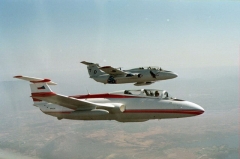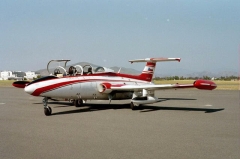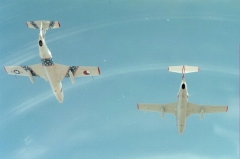L-29’s--JUST OUT FOR SOME FUN
Story and Photos by Frank Lorey
You show up at one of the numerous smaller airshows in
the Western United States, and all of a sudden to your surprise you see and
hear four jets in formation coming at you.
Is it A) the Navy Blue Angels; B) the Air Force Thunderbirds; or C) the
Thunder Delphins? If you have recently
been to airshows in El Cajon, Ramona, or Hemet you know the answer is “C”.
The Thunder Delphins jet demonstration team is actually
comprised of a total of seven planes and eight pilots flying the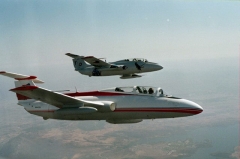 Czech-built L-29 Delphin trainer that was common in Eastern Block countries
in the mid-1960’s and well into the 1980’s.
The team leader is Doug Gilliss, and the aircraft are frequently based
out of Gillespie Field in El Cajon, CA. Usually
four planes go to perform at the airshows.
Czech-built L-29 Delphin trainer that was common in Eastern Block countries
in the mid-1960’s and well into the 1980’s.
The team leader is Doug Gilliss, and the aircraft are frequently based
out of Gillespie Field in El Cajon, CA. Usually
four planes go to perform at the airshows.
Production of the L-29 started in 1963, and a total of at
least 3,600 were produced, with 3,000 of those going to the Soviet Air
Force. Other countries to fly the
Delphin were Czechoslovakia, Iraq, Bulgaria, Egypt, East Germany, Hungary,
Nigeria, Rumania, Syria, Uganda, Indonesia, and Guinea. Most of the aircraft now showing up in the
United States are ex-Soviet models.
The L-29 Delphin started out as an advanced trainer, but
as the L-39 was phased in beginning in 1975 it became the standard beginning
and intermediate jet trainer. Top
speed is listed at 407 MPH, and it can climb at almost half a mile per minute. It cruises at 286 MPH and has a ceiling of
36,000 feet with its pressurized cockpit. By the end of production in 1974,
a couple of specialized versions were built.
The L-29A was the Delphin Akrobat, a single-seat model specially built
for airshow performances; 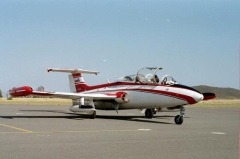 and
the L-29R was a counter-insurgency attack/recon. version.
and
the L-29R was a counter-insurgency attack/recon. version.
Wingspan is almost 34 feet, and the Delphin is a little
over 35 feet in length. It has an
internal range of 398 miles, and with drop tanks can reach as far as 555
miles. The production models also had
two wing hard points for external weapons stores.
There were several reasons for selecting the Delphin,
according to Gilliss--“The 29’s make more noise, they out-turn the L-39, they
are extremely reliable and durable, and the parts and maintenance are
unbelievable,” he remarked, adding that “the annual is less than a Bonanza’s,
and the engine is cheaper than a Cessna’s.”
There are three or four warehouses full of parts in the United States,
and the engine is extremely simple to maintain. Those reasons are exactly why the Delphin beat out designs from
the other Eastern Block countries to become the mainstay trainer of the Soviets
and other countries.
Together, the group of eight Thunder Delphins pilots has
over 30,000 combined hours of flight time, with a wide variety of
experience. They have been to airshows
as far away as Reno and Tucson, and really don’t plan to go much further
away. As Gilliss commented, the
Delphins “have an easy 300-400 mile range.”
The four main pilots are Gilliss, Doug Medore, Cas Casillas, and Don
Goodin. Four others substitute at
times.
Gilliss is a former USAF pilot who flew the F-5 Tigershark
at the end of the Vietnam war. He
also had experience in the C-123 Provider and T-38 trainer. He has flown more than 40 different types of
aircraft in a career spanning over 35 years and 5000 flight hours, and holds
commercial, flight instructor, and airline transport pilot ratings. Doug has become the checkout pilot in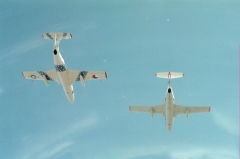 the
L-29.
the
L-29.
Of all the aircraft Gilliss has flown, he rated the F-5
as the most fun, but said it is far too expensive while saying that for jets,
“the L-29 is like a VW Bug. It glides
real nice, works like a T-33--in fact it has the same profile once you take off
and get it moving.” About the only
somewhat negative comment he made is that many people don’t think the Delphin
is very glamorous.
Doug Medore is a former Navy pilot who graduated from Top
Gun and then went back as an adversary pilot to simulate Mig attacks, flying
the F-5E in that role. During his Navy
career he flew the F/A-18 Hornet off aircraft carriers, and has accumulated
over 6000 flight hours. Medore now
flies 747’s and 757’s for UPS, and has airshow experience in Steermans, T-6
Texans, and T-28 Trojans.
“Cas” Casillas has been flying the L-29 for about a year
now. He is a retired USAF Colonel, and
had a career spanning three decades and about every fighter from the F-86
Sabrejet to the F-15 Eagle, basically the whole age of USAF jets.
Casillas flew 105 missions in Vietnam in the F-105 “Thud”, and is
retired now. His military career of
over 5000 hours in jet fighters also brought him the Silver Star, Distinguished
Flying Cross, and Air Medal with 16 clusters.
Don Goodin is the fourth regular pilot, and has the most
overall experience at more than 12,000 hours.
He is also retired USAF, and was a Lt. Colonel who flew A-37 close air
support missions in Vietnam. Goodin said he loved flying the A-37, but thinks
the L-29 is even more fun. He also
regularly flies the T-34 Mentor, as do the rest of the Thunder Delphins team
members.
While it is still possible to purchase an L-29 Delphin for
as little as $18-25,000 the more reasonable amount for one in 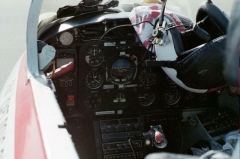 flying
condition would be in the $60-100,000 range, as Gilliss put it--“still very
reasonable for what you get.” The
low-priced Delphins are usually found in Europe, and are in crates completely
disassembled. Some have worn-out engines
and other problems that you can’t see through the crates. It also costs about $9000 for shipping to the
U.S.
flying
condition would be in the $60-100,000 range, as Gilliss put it--“still very
reasonable for what you get.” The
low-priced Delphins are usually found in Europe, and are in crates completely
disassembled. Some have worn-out engines
and other problems that you can’t see through the crates. It also costs about $9000 for shipping to the
U.S.
The jets have to be certified by the ATF, which means the
ejection seat has to be made safe or completely disarmed. It also must have no weapons, gun sights,
cameras, etc. to pass with the Defense Department. Most people are adding paint, radios, GPS, beacons, and
transponders which brings the price tag up to nearly $100,000. With all of that done, you have a jet
fighter capable of over 400 MPH that can withstand 8G’s and land at a 4,000
foot airstrip. There certainly aren’t
many aircraft that can match those capabilities at that price. The rest of the aircraft is basically stock
for the former Soviet Union days, including the instrumentation.
Gilliss is willing to help would-be purchasers, and is
always available to give advice. He
recommends talking with a current L-29 owner, and joining the Classic Jet
Aircraft Association (CJAA). He
cautions that “the LOA is not typically given to low-time, single-engine, light
aircraft pilots.” He can be reached at
dgmail@adnc.com.
“When all is said and done, these jets are fun, fun, fun,” he remarked. Gilliss noted they are “a casual team, not professional, and we probably lose money each week. We just do it to have fun together.” After flying with the Thunder Delphins, I can attest that the fun is quite contagious.
